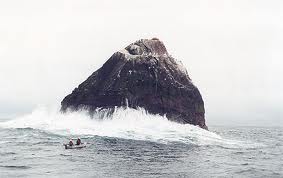Ireland is recalculating its claim to potentially oil and gas-rich Atlantic waters — right down to the very last centimetre including Rockall off the coast of Donegal.
For the first time in almost 60 years, the exact measurements of the country’s territorial waters, including part of the disputed Rockall Bank, are being taken from 50 specially selected points.
Operation Baseline will help chart more accurate maritime maps and be used to cement claims to the continental shelf up to 565km from shore.
Over the last few weeks, the Air Corps winched geographers on to some of the most inaccessible headlands and islands on our shores to mark co-ordinates first given to the UN in 1959.
A Department of Foreign Affairs official told the Irish Examiner: “The new co-ordinates will be used to update electronic maritime charts and the project will also allow the outer limits of the State’s maritime zones to be determined with much greater accuracy.
“More accurate mapping is important for a range of matters, including exploration, licensing and law enforcement.”
As part of the operation, an Ordnance Survey Ireland (OSi) team used GPS to pinpoint the 50 locations and permanently marked them with brass plates.
The most northerly is Scart Rocks off Malin Head, with the western extremities including an unnamed rock beside Black Rock lighthouse off Mayo and the Great Foze Rock off the Blasket Islands in Kerry. Along the south coast, Bream Point on Cape Clear in Cork and Carnsore Point in Wexford are on the limits.
Andy McGill, Operation Baseline co-ordinator with the OSi, said: “Basically, it is redefining the territorial limits.”
Ireland has a 19km territorial sea and a 321km exclusive economic zone before any additional claims are made to the continental shelf, including the Rockall Bank.
The Geological Survey of Ireland says potential territorial waters stretch to 898,442km sq — an area bigger than the oil-rich North Sea.
However, claims to Rockall itself are virtually pointless under international law.
Tags:








